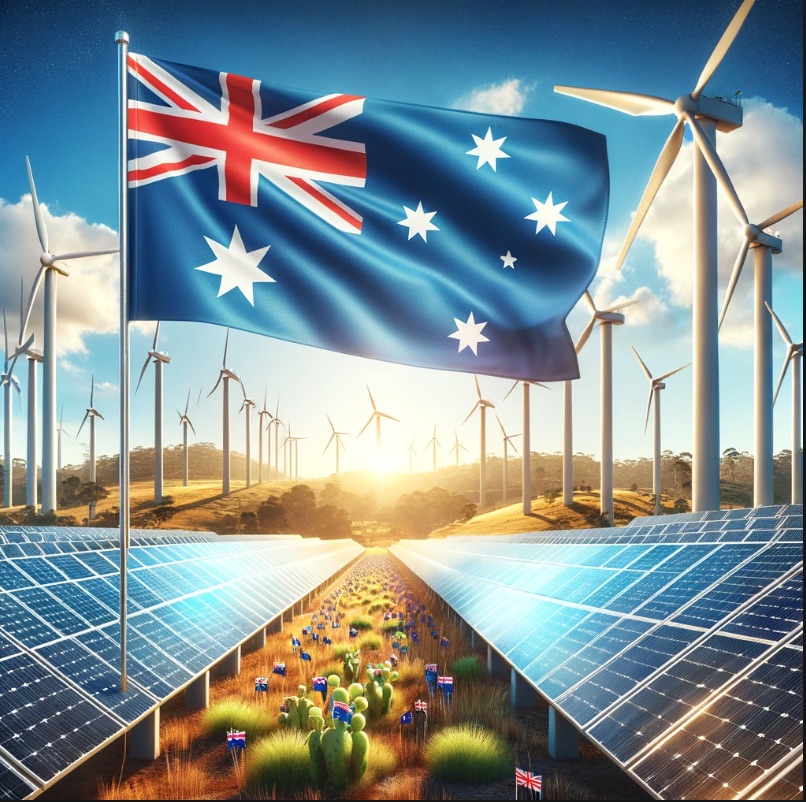1. Overview: A Market in Transition
Australia’s energy market is undergoing a seismic shift. The National Electricity Market (NEM) spans most of the eastern states, and reforms aim to decarbonize while maintaining reliability. Coal retirements accelerate, while renewable integration is scaled through rooftop solar, wind farms, grid-scale batteries, and new transmission lines.
National targets:
The Australian Energy Market Operator (AEMO) and regulators continue to drive reforms across planning, operations, and investment.
2. Renewable Energy Growth
-
Renewable energy supplied ~40% of Australia’s electricity in 2024.
-
On peak days, renewables covered over 75% of NEM demand.
-
Over 4 million rooftop solar systems are now installed.
-
Annual renewable capacity added in 2024 exceeded 5.2 GW.
-
Wind, utility-scale solar, and grid-scale batteries are rapidly increasing.
Rooftop solar contributes ~12% of electricity demand, while wind and large solar installations provide utility-scale generation. Storage is expanding but lags generation growth.
3. Infrastructure & Grid Transformation
The grid is being redesigned for a decentralized, variable future.
-
Renewable Energy Zones (REZs) are being built to co-locate wind, solar, and batteries.
-
Multiple REZs are operational or planned across NSW, Victoria, Queensland, and Tasmania.
-
Project EnergyConnect, a 900 km interconnector between SA and NSW, began operations in 2025.
-
Battery projects and pumped hydro are rising to support evening peak demand.
AEMO’s Integrated System Plan highlights $20 billion+ of transmission investment required this decade to meet renewable integration goals.
4. Electricity Prices and Inflation Pressures
While renewable costs per unit fall, the overall electricity bill for households has risen due to:
-
Higher wholesale market volatility
-
Delays in new projects coming online
-
Infrastructure investment passed on to consumers
In some areas like New South Wales, household electricity bills rose by up to 9% in mid-2025. This contributed to a spike in inflation, which reached 2.8% year-on-year by July 2025.
Despite this, the long-term goal remains energy cost reduction through efficiency and scale.
5. Political and Policy Landscape
Australia’s federal and state governments are actively legislating to meet climate and energy targets:
-
National green energy targets are legally backed.
-
EV incentives, home battery rebates, and renewable project fast-tracking continue.
-
Some political debate remains over introducing nuclear or extending gas as transition fuels.
Public support for renewables remains strong, but concerns are rising over affordability and reliability. Balancing clean energy acceleration with cost and stability is now the top policy challenge.
6. Opportunities for Investors
Australia’s energy transition opens new fronts for investors:
Transmission & REZs
Consumer Energy Tech
-
Rooftop solar, smart inverters, battery storage, and energy efficiency tools are gaining household traction.
Commercial and Industrial (C&I)
Utility-scale generation
-
Large wind, solar, and hybrid (solar + storage) projects have strong offtake visibility, especially in REZs.
Emerging sectors
-
Green hydrogen, VPPs (Virtual Power Plants), EV charging infrastructure, and smart grid analytics are growth frontiers.
7. Market Risks & Challenges
-
Grid congestion: Too many projects without corresponding transmission leads to curtailment.
-
Slow permitting: Environmental and social approval delays can hinder projects.
-
Cost inflation: Equipment, labor, and interest rate pressures squeeze margins.
-
Community resistance: Wind and transmission projects face localized opposition.
-
Revenue volatility: Spot market fluctuations may harm merchant power producers.
8. Future Outlook (2025–2030)
Australia’s energy transformation is real, but difficult. Key future trends include:
-
Rooftop solar will continue to expand due to consumer economics.
-
Battery storage (both grid and behind-the-meter) will scale fast to fill solar evening gaps.
-
Wind and solar REZs will become the dominant utility-scale strategy.
-
Transmission planning will become more dynamic and investor-friendly.
-
Affordability and reliability will take center stage politically.
The goal of 82% renewable electricity by 2030 is feasible, but demands relentless execution, policy consistency, and regulatory support.
9. Summary Table: Key 2025 Facts
| Metric |
Value |
| Renewable share of electricity |
~40–46% |
| Rooftop solar installations |
Over 4 million |
| Annual renewable capacity added (2024) |
5.2 GW |
| Target renewable share by 2030 |
82% |
| Inflation (July 2025) |
2.8% |
| Grid record (peak day) |
75.6% renewable generation |
| Interconnector milestone |
Project EnergyConnect operational |
| Electricity bill hikes (2025) |
Up to 9% in some states |
10. Conclusion: Market on the Move
Australia’s energy system is on a transformative journey—expanding renewables, modernizing its grid, and balancing cost and emissions targets. The next five years are critical.
-
For consumers, energy independence (solar + batteries) is increasingly attainable.
-
For investors, REZs, transmission, storage, and digital energy solutions offer long-term opportunity.
-
For policymakers, affordability and resilience will define success in 2030 and beyond.
With political will, private capital, and public engagement aligned, Australia’s energy future is both green and bright.







